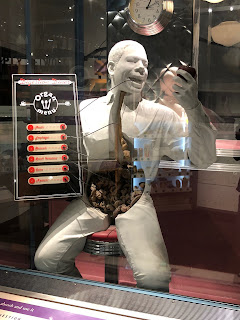Event 3: Body Worlds
 |
| Digestive System Display |
For my second event, I visited the Body Worlds exhibit at
the California Science Center. The exhibit features human organs and organ
systems separated and preserved, enabling viewers of the exhibit to view first hand
the different structures and functions of different parts of the human body.
Thought the exhibit showed primarily individual systems, it conveyed well the interdependence
of the systems on each other.
 |
| Ancient Egyptian Dissection |
Being at the exhibit made me realize how far the human understanding
of the human body and the representation of the human body has come. The first
instances of dissections of recorded trace back to Ancient Egyptians (Vesna).
After the death of Egyptians, their bodies would be cut open and mummified.
This process often entailed skilled morticians altering the bodies in ways that
preserved them for thousands of years. This process has been captured in much Egyptian
art and is well-known today. Art and science were truly joined in this
undertaking. Like the exhibit at the California Science Center, these drawings provided
Egyptians and the viewers of their art with a representation of the human body
(Buck).
In 1979, the idea of Body Worlds was conceived by Guther von
Hagens. Through the process of plastination, in which water and lipid molecules
are chemically extracted form the body and plastic polymers replace them (Grant).
The exhibits featured items like non-decaying bodies playing poker, performing
gymnastics, and other common activities, as well as displaying organ systems.
 |
| Body Worlds Cadaver Playing the Sax |
 |
| Heart Exhibit |
Like many new forms of art however, Body Worlds was called into
question. The idea of human bodies being displayed for profit very much
disturbed some people, despite it luring many crowds. It was outlawed in
France, among other places, under the premise that “under the law, the proper
place for corpses is in the cemetery” and that "it was a violation of the respect
owed to them” (Schecter). Counter arguments for the exhibit included the fact
the people voluntarily gave their bodies and as many as 6,000 people are on the
waiting list (Grant). Another counter argument was that showing the organ
systems was very informative. The benefits of living healthy lifestyles are
very visually displayed and were thought to encourage healthy living (“Dead Body
Show…”). At the California Science Center, there were no corpses performing
daily activities, but the display of organ systems was certainly informative.
 |
| Brain Exhibit |
Buck, Alanah. “Death, Decay, and Dissection in Ancient Egypt.” Western Australia Museum. Western Australia Museum, 7 June 2013.
“Dead Body Show Promotes Health.” Fox News, 24 Oct. 2009.
Grant, Alexis. “Closing of Body Worlds Exhibit Draws Record Crowds.” Houston Chronicle, 4 Sept. 2006, chron.com.
Schecter, Anna. “France Shuts Down Popular Bodies Show.” Abc News, 23 Apr. 2009.
Vesna, Victoria, director. Medicine Pt 1. Youtube, 21 Apr. 2012.
 |
| Photo Evidence of Attendance |



Comments
Post a Comment